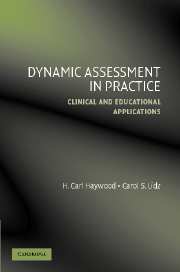Book contents
- Frontmatter
- Contents
- Preface
- Foreword, by Kenneth A. Dodge
- Foreword, by Thomas Oakland
- PART ONE THEORY AND PRINCIPLES
- PART TWO APPLICATIONS
- 4 Dynamic Assessment in Clinical Settings
- 5 Dynamic Assessment in Educational Settings
- 6 Applying Dynamic Assessment with Young Children
- 7 Applying Dynamic Assessment with School-Age Children
- 8 Applying Dynamic Assessment with Adults and Seniors
- 9 Writing Reports and Developing IEPs and Service Plans with Dynamic Assessment
- 10 Unresolved Issues, Conclusions, and Recommendations
- APPENDIX A TESTS REFERRED TO IN THE TEXT THAT DO NOT BELONG TO THE AUTHORS
- APPENDIX B SOURCES OF DYNAMIC ASSESSMENT MATERIALS
- References
- Author Index
- Subject Index
- Tests and Testing Materials Index
4 - Dynamic Assessment in Clinical Settings
Published online by Cambridge University Press: 04 December 2009
- Frontmatter
- Contents
- Preface
- Foreword, by Kenneth A. Dodge
- Foreword, by Thomas Oakland
- PART ONE THEORY AND PRINCIPLES
- PART TWO APPLICATIONS
- 4 Dynamic Assessment in Clinical Settings
- 5 Dynamic Assessment in Educational Settings
- 6 Applying Dynamic Assessment with Young Children
- 7 Applying Dynamic Assessment with School-Age Children
- 8 Applying Dynamic Assessment with Adults and Seniors
- 9 Writing Reports and Developing IEPs and Service Plans with Dynamic Assessment
- 10 Unresolved Issues, Conclusions, and Recommendations
- APPENDIX A TESTS REFERRED TO IN THE TEXT THAT DO NOT BELONG TO THE AUTHORS
- APPENDIX B SOURCES OF DYNAMIC ASSESSMENT MATERIALS
- References
- Author Index
- Subject Index
- Tests and Testing Materials Index
Summary
The term “clinical settings” in this chapter's title refers to those places and circumstances where people go to get help with psychological, educational, and social problems. We deliberately separate such settings from schools. In the latter case, people go there for learning whether or not they have problems. Thus, clinical settings are by definition problem-solving settings. This emphasis means, for one thing, that assessment activities can have a sharper focus: Although finding the precise nature of problems is often a clinical task, discovering whether problems exist is usually not an essential part of that task. School settings and clinical settings differ in the typical nature of the problems that require assessment and, most important, in the outcomes of assessment. In school settings as well as in clinical settings dealing with school-related problems, the outcomes must have clear implications for classroom management and instruction. In clinical settings the outcomes may be considerably broader, the age span of the clients wider, the services available for follow-up more varied, and the outcomes should have clear implications for treatment. In such settings, DA can be especially useful in getting at elusive information that may be more difficult to obtain than is true in more typical settings, particularly information on abilities and performance potential and on the sources of intelligence masking.
The three major problem groups that we deal with in this chapter are psychopathology, developmental disabilities, and neurological disorders.
- Type
- Chapter
- Information
- Dynamic Assessment in PracticeClinical and Educational Applications, pp. 47 - 73Publisher: Cambridge University PressPrint publication year: 2006



